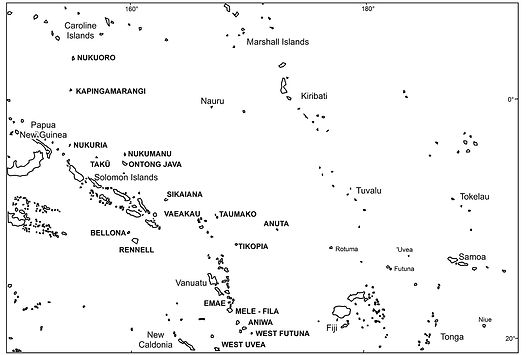The Polynesian Outliers
The region commonly termed “Polynesia” includes thousands of islands, most of them arranged in a rough triangle bounded by Hawai‘i, Easter Island, and New Zealand. Outside the Polynesian Triangle, in areas commonly designated Micronesia and Melanesia, lie about two dozen islands, most of them small and widely separated, whose inhabitants speak Polynesian languages and share other characteristics with triangle Polynesians. These islands are collectively termed the Polynesian outliers.
The great Polynesian centers endured major change before trained observers had an opportunity to record their lifeways. In contrast, owing largely to their remote location, the outliers were spared much of the trauma suffered by their larger and more accessible neighbors, making them particularly interesting for anthropologists, and critical for the comparative study of Polynesia. Who are these peoples? Where did they originate, and how did they come to settle in these remote islands? What is their relationship to the better-known Polynesian societies? Can they, in some way, be thought of as representing ancient Polynesia before it became permanently altered by contact with Europeans? I have collaborated with many anthropologists who have worked in these islands to produce a new volume exploring these and other questions and to provide the first synthetic, comparative treatment of the Polynesian outliers. The settlement and development of these remote outposts of Polynesia can also teach us much about human migration and mobility in Oceania.
.png)

The Polynesian Outliers

 Tikopian costumes |  map of Tikopia based on Sir Raymond Firth's work |  tattooed women of Rennell Island |
|---|---|---|
 volcanic island |  coral reef island |